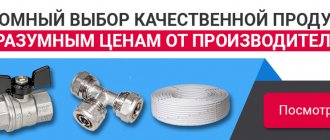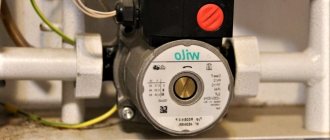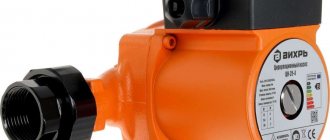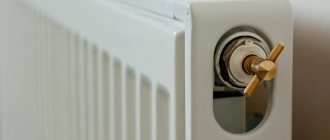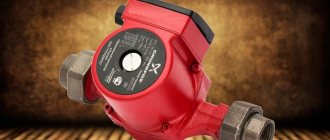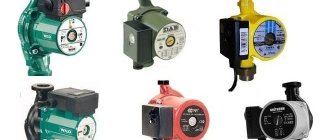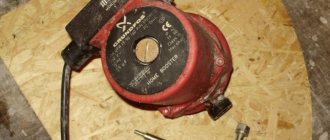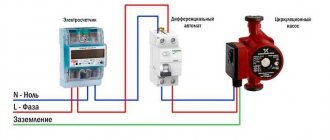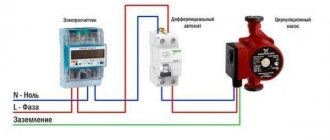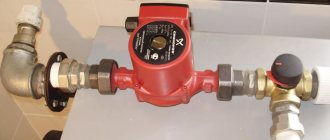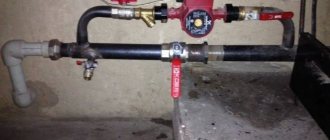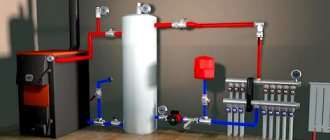What is a circulation pump?
This equipment plays a huge role in the functioning of the thermal system of any room. If the heating system is not equipped with a circulation pump, then the heating process will be affected by all climatic temperature changes.
In another situation, if an error occurred during the installation of heating equipment, the circulation device will also not be able to work. After all, the entire thermal circuit is broken.
The circulation pump operates according to a specific heating pattern, which helps to heat the room.
- The device is a closed circuit, which is directly dependent on the heating boiler.
- This container is connected to a break in the heating circuit.
- In this case, the heated coolant comes out of the boiler, which passes through a circle, giving off heat and returning back to the container.
- That is, the reverse operation of thermal equipment occurs.
- The activity of the coolant depends on the speed of fluid movement in the heating system.
Advantages of circulation devices
Until 1990, heating systems in private buildings were designed and built primarily without pumps. The coolant moved through the pipes by gravity, and its circulation was ensured by convection flows of liquid when it was heated in the boiler. Currently, natural circulation systems are still used, although not as often.
Inexpensive solid fuel boilers are produced without built-in pumps, because the manufacturer does not know the parameters of the heating circuit. For such systems, the purchase of a water pump is mandatory.
Nowadays, coolant movement is carried out forcibly using water pumps, which have a number of advantages:
- Reduced load on the boiler by reducing the temperature difference in the incoming and outgoing pipes.
- Uniform distribution of heat throughout the rooms due to the same temperature of the coolant along the entire length of the heating rings.
- The ability to quickly regulate the temperature of the coolant.
- Quick heating of the heating system when starting a cold boiler.
- There is no need to install pipelines with a slope towards the boiler, ensuring spontaneous movement of the coolant.
- Possibility of using thin pipes that take up little internal space in the apartment.
- The power of the pump allows you to build up pressure in the heating circuit sufficient to supply coolant several floors up.
- Use of shut-off valves on individual loops of heating networks.
- Possibility of integrating the pump into the automatic control system of the boiler.
With a lot of advantages, circulation devices also have two disadvantages - dependence on power supply and additional costs for electricity.
But the disadvantages are easily compensated for - installing a water pump allows you to save 10-20% of fuel, and the share of the cost of electricity in total heating costs is only 3-5%. In addition, if there is a frequent lack of electricity, you can install a UPS, which will ensure autonomous operation of the boiler and pump for a certain period.
Why do you need a circulation pump?
When it cools down, it will be difficult to regulate the heat supply. It is in this case that a circulation pump is used, which creates pressure for the heating system.
Water cycling occurs strictly after a certain period of time, stabilizing the entire heating system.
- Modern heating boilers of most types are equipped with circulation mechanisms.
- But it often turns out that this is not enough and the power of the equipment suffers in the presence of a branched radiator circuit.
- Another example when a circulation system is mandatory is the connection to the heating boiler of not only radiators, but also a heated floor.
These two options will not be able to transfer heat to the room if the heating equipment is of low power.
Efficiency requirements
The circulation pump for the heating system is selected based on the maximum heat demand, i.e. maximum coolant flow during the period of severe frosts.
Research shows that more than 70% of the heating season the pump operates at 50% or less capacity. This is due to changes in outside air temperature and the thermal needs of the building.
During periods of low heat demand the installation is throttled, for example using thermostatic valves or other flow controllers, during which time lower flow and speed limits apply to electronic pumps.
To calculate the required flow rate, you can use the following formula:
Where:
- Q is the required pump capacity (m3/h);
- P is the thermal power “transmitted” by the installation (kW);
- c - specific heat capacity of water 4.19 kJ / (kg x K);
- g is the coolant density, (for water g = 1 kg/dm3);
- ΔT—difference between supply and return temperatures (°C):
- ΔT = 20 °C for radiator heating;
- ΔT = 10°C for underfloor heating;
- ΔT = 10 °C to maintain the temperature of the storage tank;
- ΔT = 15 °C for boiler object for "hydraulic coupling".
Thus, for an installation example in a single-family house with a heating output of 25 kW, where the heat sink is a floor-mounted installation and the temperature difference between flow and return is 10 ° C, the required flow is: Q = 2.15 m3/h
And we already have a calculation of the required flow rate for our plant. The second necessary parameter when choosing a pump is pressure.
Types of pumps
Manufacturers offer two types of such devices:
- Glandless rotor pump. Suitable for domestic premises. The device is installed on the motor shaft. The pump housing has a sealed system. The shaft is equipped with a seal that protects the device from leaks. The peculiarity of the device with a wet rotor is that it is almost silent and prevents air stagnation;
- Dry rotor pump. Suitable for large industrial premises. The device consists of two units (pump and motor), which are connected by a coupling or flange. The equipment is characterized by loud pump operation.
Which device model to choose
Cost is often the deciding factor when purchasing equipment. It is believed that the highest quality products are expensive and are produced only by Western European companies. However, the famous Danish company Grundfos has production branches in Russia, Poland, Serbia and many other countries.
The main parameters of the pumping equipment can be found on the device body. For example, the inscription Grundfos UPS 32–40 180 informs the buyer that the diameter of the pump connecting pipe is 32 mm, the power consumption of the unit is 40 W, and the installation length of the housing is 180 mm.
All modifications have three operating speeds with manual switching, which allows you to select the optimal mode to save energy. A maximum operating pressure of 10 bar is standard for domestic central heating units. The cost of various models ranges from 6,400 to 17,300 rubles, depending on performance.
Products from Wilo (Germany), Sprut (China), BPS (Russia) are popular on the market:
- Wilo produces pumps for solid fuel boilers with connection sizes from 15 to 32 mm, operating pressure 4–10 bar and costs from 5,750 to 8,000 rubles.
- Sprut produces central heating units with connection sizes from 15 to 25 mm, operating pressure 4–10 bar for solid fuel boilers with coolant temperatures up to 110 °C. Price - from 2240 to 4750 rubles.
- BPS manufactures pumps with external threads on connecting pipes with a diameter of 20 and 32 mm, operating pressure 4–10 bar for solid fuel boilers with coolant temperatures up to 110 °C. The maximum performance model has flanges instead of threads. Cost - from 2480 to 8000 rubles.
The listed technical characteristics are valid only when using water as a coolant. If antifreeze is used, then during calculations it is necessary to enter a correction factor depending on the concentration of the antifreeze liquid.
Technical specifications
Each such equipment is characterized according to technical standards. It is these nuances that show for which room the circulation pump is suitable and how it will be installed in the heating system.
Performance
The first technical characteristic is pump performance. This is an indicator of the amount of coolant that will be pumped per unit of time. It is this factor that determines the speed of the fluid in a given system.
Pressure
This mechanism determines the height of the liquid column. Pressure is especially important for housing construction consisting of several or more floors. This is explained by the fact that the hydraulic resistance in multi-story buildings is very high, and the pressure mechanism helps to regulate this system.
Power
Also a very important indicator. Since the low power of the circulation pump will not allow it to perform all the specified work for the heating system in full.
Otherwise, with high power of the mechanism, the pipes will make a lot of noise.
Temperature
The circulation pump in this situation must withstand high temperatures. If this does not happen, the device will quickly become unusable. Since we are talking about a heating system, each functionality of the device will increase the temperature regime of all heating equipment.
Dimensions
Sooner or later installation of this device will be required. But the task is complicated by the fact that the pump requires certain sizes of spare parts, which may not be available some time after the release of this device. Therefore, it is recommended to buy such parts immediately with a circulation pump.
Production
The pump manufacturer does not determine its full functionality. But one thing is certain: a responsible and well-known company will not risk its reputation. And he will do everything possible to ensure that the circulation pump does its job in full and pleases customers with a long service life.
Manufacturers and prices
When choosing manufacturers of a circulation pump, the approach is the same as when selecting any type of equipment. If possible, it is better to take equipment from European manufacturers who have been on the market for a long time. The most reliable circulation pumps in this sector are Willo, Grundfos, and DAB. There are other good brands, but you need to read reviews for them.
| Name | Performance | Pressure | Number of speeds | Connection dimensions | Maximum working pressure | Power | Housing material | Price |
| Grundfos UPS 25-80 | 130 l/min | 8 m | 3 | G 1 1/2″ | 10 bar | 170 W | Cast iron | 15476 RUR |
| Caliber NTs-15/6 | 40 l/min | 6 m | 3 | external thread G1 | 6 atm | 90 W | Cast iron | 2350 rub. |
| BELAMOS BRS25/4G | 48 l/min | 4.5 m | 3 | external thread G1 | 10 atm | 72 W | Cast iron | 2809 RUR |
| Gilex Compass 25/80 280 | 133.3 l/min | 8.5 m | 3 | external thread G1 | 6 atm | 220 W | Cast iron | 6300 rub. |
| Elitech NP 1216/9E | 23 l/min | 9 m | 1 | external thread G 3/4 | 10 atm | 105 W | Cast iron | 4800 rub. |
| Marina-Speroni SCR 25/40-180 S | 50 l/min | 4 m | 1 | external thread G1 | 10 atm | 60 W | Cast iron | 5223 RUR |
| Grundfos UPA 15-90 | 25 l/min | 8 m | 1 | external thread G 3/4 | 6 atm | 120 W | Cast iron | 6950 rub. |
| Wilo Star-RS 15/2-130 | 41.6 l/min | 2.6 m | 3 | internal thread G1 | 45 W | Cast iron | 5386 RUR |
Please note that all specifications are based on water movement. If the coolant in the system is a non-freezing liquid, adjustments must be made. You will have to contact the manufacturer for relevant data for this type of coolant. It was not possible to find similar characteristics in other sources.
Advantages and disadvantages
Circulation pumps, like any equipment, can be characterized on both positive and negative sides.
Pros of the device:
- Normalization of the operation of the heating system with uniform movement of the coolant;
- Changing the heating mode, which will significantly save the family budget;
- Fast heating of the room due to the high speed of movement;
- Minor heating defects are eliminated without human intervention, thanks to the start of cycling by the pump;
- Reliability of the device with operation in case of minor malfunctions of the heating system;
- Long service life due to the use of high-quality material in the production of circulation equipment;
- A wide range of products <<for every pocket>> and for any room.
Disadvantages of the device:
- The pump does not work without power supply;
- Electricity charges will be higher;
- If there is a lack of electricity, the circulation pump stops;
- Additional financial costs <<for embedding the pump>> into the heating system.
Experts have come to a common opinion that the use of a circulation pump solves many problems when heating both residential and non-residential premises.
Therefore, the issue of purchasing this equipment should be resolved in a positive way, because without a pump, the heating system cannot be operated normally.
Features of equipment marking
Unfortunately, there are no standardized requirements for the labeling of circulation pumps. Manufacturers independently choose a list of technical characteristics that are indicated on the device body.
When purchasing a pump, you should not rely only on the markings. It is better to open the instruction manual and read the technical specifications there
The front panel typically displays the following information:
- direction of coolant movement;
- diameter of connected pipes;
- maximum permissible pressure;
- manufacturer and model;
- maximum operating temperature;
- degree of protection;
- operating parameters of the electrical network;
- marks of compliance with national technical regulations.
Manufacturers may provide other information at their discretion. Detailed technical characteristics of the devices are indicated in the operating instructions.
Units of measurement vary from country to country, so the numbers on the case can be deceiving. It is better to once again open the instructions, where, along with the characteristics, their units of measurement are also indicated.
Photos of the best models of circulation pumps
Why are centrifugal industrial pumping units needed?
Centrifugal heating pumps provide the required temperature in residential and non-residential premises.
Industrial installations have greater power and allow uninterrupted operation at production sites. is capable of heating rooms up to 2,200 sq.m. The task of centrifugal pumps is to ensure continuous movement of the coolant.
Usually it is water, but air mass or other easily moving liquids can be used.
Where can I order?
LLC "Kvadr" has been supplying pumping equipment since 2000. Equipment we supply:
- reliable: ensures uninterrupted operation according to the specified technological regime;
- economical: allows you to save up to 45% of electricity and increase the overhaul interval up to 30%;
- certified;
- optimal in terms of price-quality ratio.
Our advantage is comprehensive customer service . On our own we provide:
- carrying out pre-design calculations;
- quick selection of pumps taking into account the individual needs of the customer;
- supply of complete pumping stations;
- professional installation and commissioning;
- maintenance and repair.
We develop individual projects for clients, selecting only equipment that is beneficial for them. We are ready to complete the work in a short time frame so that you can deliver the project on time or start production. There are often cases when only 1–2 weeks pass from signing the contract to the launch of the equipment.
Centrifugal pumps are an excellent way to solve the problem of heating industrial premises. ready to offer you high-quality solutions, promptly supply, install and put into operation the necessary equipment at an affordable price.
Step-by-step instructions for assembling and installing the pump
After purchasing the device and choosing the location for its installation, it is necessary to carry out assembly and installation. It is first necessary to install ball valves on both sides of the pump, and install a mud trap in front of the unit to retain scale, dirt, and abrasive particles. The upper part of the bypass must be equipped with an air valve.
Assembling and connecting the pump to the heating boiler is carried out in the following sequence:
- Before installation, drain the liquid from the system. For complete cleaning, you need to fill it with coolant and drain it, then repeat this procedure a couple more times.
- Install the pump into the system.
- After installation, all connections must be carefully sealed.
- Fill the system with liquid. Remove excess air.
- Connect the device to the electrical network.
The number of circulation devices required in the system depends on the length of the pipeline.
Installation rules and nuances
It is advisable to entrust the installation of the pump to a specialist. In the technical documentation, the manufacturer indicates installation rules, so you can try to do the work yourself. The main thing is to adhere to the rules for handling the device.
To avoid the formation of air pockets, which can lead to equipment breakdown, it is important to choose the correct location of the rotor relative to the horizon. There is a hint on the body of the device in the form of an arrow indicating in which direction the liquid in the system should move. The site must be selected in a place convenient for operating the unit.
Installation diagram
There are several schemes for connecting the pump to the boiler. The desired option is selected based on the type of system and type of heating equipment. In all schemes, the device is mounted so that it is comfortable to service.
Possible methods:
- The unit is installed on the return line directly in front of the heat generator.
- The pump is installed at the beginning of the circuit after the safety group.
- The device with shut-off valves is placed on the bypass.
- Used when connecting the pump to a solid fuel boiler. It is better to fix the device on the line that goes from the heating system to the heat generator.
Installation of a circulation device on the return line.
How to connect to power supply
The device operates from a 220 V network. Connection requires three wires: phase, neutral and ground.
It can be connected to power in two ways:
- Directly by cable or via terminal block. It is necessary to draw a separate electrical line with a circuit breaker, and use this cable to connect the device. The terminals are usually located under a plastic cover. You need to remove it by unscrewing several bolts and finding three connectors. They are signed: pictograms N - neutral wire, L - phase, and “ground” has an international designation.
- Through a three-pin socket and plug. New wiring needs to be done. Install an external or internal outlet. To connect the unit to the network, you will need a power cable with a grounding plug.
When to install additional equipment
The functioning of the entire heating system depends on the performance of the pump. To prevent sudden shutdown of the unit, it is worth additionally providing backup power. To do this, you can install a stabilizer with connected batteries. The main thing is to correctly select and calculate the capacity of the devices and ensure that they do not discharge.
You can reduce energy costs and increase the service life of the device by installing a thermostat that measures the temperature of the liquid. The pump will start if the indicator reaches the required level.
Service
Ensuring the normal operation of a water unit is impossible without timely maintenance, routine and major repairs. In general, we can highlight the standard deadlines for their implementation (in hours worked by the unit):
- maintenance – 700–750 hours;
- current repairs – 4.3–4.5 thousand hours;
- major repairs – 25–26 thousand hours.
The simplest types of work are carried out with regular maintenance. Within its framework, the following are checked:
- condition of bearings, couplings and gasket material on bearing caps;
- integrity of oil seals and protection sleeves;
- alignment and fastening of the centrifugal pump.
If necessary, worn parts are replaced with new sets. The oil is also changed, all oil pipes and hydraulic protection pipes are washed and purged.
Current repairs include the following work:
- complete disassembly of the pump;
- complete inspection of all parts of the unit;
- checking the rotor for absence of runout in the housing inserts;
- checking the housing for the formation of cracks and gaps;
- checking the shaft journal for the formation of wear;
- eliminating detected defects or replacing worn parts with new ones;
- replacement of rolling bearings.
During a major overhaul, in addition to the work mentioned above, all moving parts and assemblies are checked most thoroughly, heavily worn parts are replaced with new ones, and the housing seats of the supporting foundation are corrected.
After completing the entire cycle, the pump is tested by injecting a pressure exceeding the maximum allowable by approximately 0.5 MPa.
